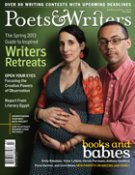Young-adult fiction author Mike Mullin learned through Pinterest that he had inspired another artist to become the face of his fictional character on film. Writer and social-media expert Nicole M. Miller discovered a long-lost relative, albeit of the equine variety, when she posted a picture of her horse on Pinterest. Experiences like these have writers realizing that the social-networking site is useful for more than just collecting cute cat pictures, cupcake recipes, and couture collages. Instead of seeing the fast-growing image-sharing service as the world’s most time-consuming digital corkboard, innovative authors are using it as a new way to connect and converse with readers, editors, agents, and fellow writers. They are also creating Pinterest boards to curate content for new projects, construct elaborate author platforms that help them find new audiences through common interests, and even share a few pet pictures of their own. Here are some tips to help you do the same.
Be Descriptive. Although eye-catching images are the key to getting Pinterest users’ attention, captions count. Too many writers on Pinterest don’t add original captions to photos they find on the web, leaving fans to wonder what made the image so special and missing the opportunity to attract new readers with catchy captions that offer the backstory to vivid visuals. Those captions, which are limited to five hundred characters, should also include keywords. “Those keywords in the caption are the way you get found,” says Miller.
Be Collaborative. Many writers connect with other authors and editors via Pinterest, even using the site as a virtual bulletin board to plan writing conferences and collaborate on shared projects. For Miller, commenting on other writers’ collections has deepened her ties in the industry. A former rodeo queen who often writes about horses, Miller counts some horse associations among her Pinterest followers, which means that Pinterest users who follow those associations are likely to see Miller’s pinboards featuring horses. “Finding that kind of niche market…is a great way to build your following,” she says.
Be Inspired. Pinterest offers millions of images to inspire your descriptions of characters, settings, or the mouthwatering meal your protagonist prepares in chapter four. It can also provide a welcome respite from the black-and-white words on your screen when you’ve been stuck on the same sentence for hours. “Sometimes I will take a mental break from words and focus on images,” says Miller, who often trolls Pinterest for pictures to combine into composites of a character. Many writers also share photos that remind them of their imagined worlds and encourage readers to do the same. That’s how Mike Mullin connected with photographer Margot Wood, who took a self-portrait as an ash-smeared Darla, one of the characters in Mullin’s novels. “I thought it was awesome, because she really reimagined Darla,” says Mullin, who has since met Wood and now has a print of the portrait near his desk.
Be Cautious. Treat public pinboards as a way to collect vague notions rather than as storyboards for your new novels. You don’t want to give away too much or accidentally post a picture that becomes a spoiler for fans. “It’s a good way to show the thought process behind a book, the inspiration, but you don’t necessarily want pieces of your novel totally mapped out on the web,” says Miller.
Be Synergistic. Pinterest makes it simple to add “follow” buttons to websites and blogs. Facebook posts and website content with strong visuals can also be transformed into pins. You can even link your Pinterest account directly to Facebook, Twitter, and other social-networking sites, so try to use those established sites to promote your Pinterest page. “For me, it’s drastically increased my blog traffic…by almost 200 percent,” says Miller.
Be Genuine. Pinterest isn’t all about boosting blog traffic or book sales. Authors should use it as a window into their writing world and as a way to share their interests and inspirations. Mullin has a pinboard with photos and links that relate to his debut novel, Ashfall (Tanglewood Press, 2011) and its sequel, Ashen Winter (Tanglewood Press, 2012), but he’s also careful not to make his Pinterest account all about self-promotion. “Pin stuff you like, and you’ll connect with like-minded people that way,” he says. “And they’ll probably go on to discover your books.”
Charlene Oldham is a Saint Louis–based freelance writer and professor of journalism and business communications at Lindenwood University who blogs about writing
and life at charleneoldham.com.









Comments
leekearneyma@ya... replied on Permalink
Pinterest.
Thanks for the article, just beginning to move into the networks beyond Facebook.This was simple to read, easy to understand Pinterest, and gave me some thought about setting up the issues dear to my heart and manifested in my book. As a senior, this can be overwhelming. My grandkids are telling me I am getting much better at it. Thanks. Lee
MelissaTaylor replied on Permalink
More Tips for Success on Pinterest
I wrote a book called Pinterest Savvy: How I Got 1 Million+ Followers which will guide you through starting to developing a strong presence. It's been getting lots of 5-star reviews on Amazon because it's helping so many people. I'd love to send you a review copy if you're interested.
Melissa Taylor, author of Pinterest Savvy
melissa@melissatayloronline.com
MelissaTaylor replied on Permalink
More Tips for Success on Pinterest
I wrote a book called Pinterest Savvy: How I Got 1 Million+ Followers which will guide you through starting to developing a strong presence. It's been getting lots of 5-star reviews on Amazon because it's helping so many people. I'd love to send you a review copy if you're interested.
Melissa Taylor, author of Pinterest Savvy
melissa@melissatayloronline.com
JccKeith replied on Permalink
Pinterest
I found this post very helpful. I had opened a pinterest account but wasn't really using it. Thanks so much for this information.